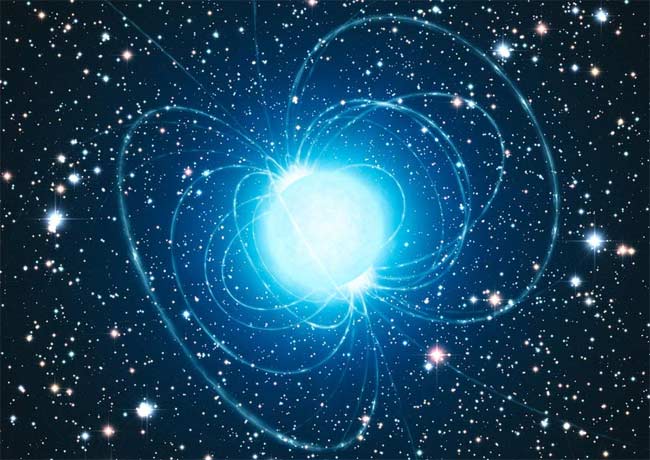Massive Mega-Star Challenges Black Hole Theories

Astronomers have discovered a massive star that once dwarfed our sun and is now challenging theories of how stars evolve, die and form black holes.
The star is a peculiar cosmic object known as a magnetar. Magnetars are extremely dense, super-magnetic stars that can form from supernova explosions.
The newly discovered magnetar is perplexing, because astronomers have calculated that its progenitor likely weighed at least 40 times as much as the sun. Large stars in this mass category are thought to become black holes, not magnetars, when they explode in supernovas.
"This therefore raises the thorny question of just how massive a star has to be to collapse to form a black hole if stars over 40 times as heavy as our sun cannot manage this feat," said researcher Norbert Langer of the Universität Bonn in Germany and the Universiteit Utrecht in the Netherlands.
When massive stars reach the end of their lives and die in supernovas, they leave behind remnants. If the star is very massive, that remnant is a black hole — an extremely dense collection of mass with such a strong gravitational pull, not even light can escape.
If the original star was slightly less massive, the supernova remnant will become a neutron star. These objects, made of mostly neutrons, are more dense than a regular star but less dense than a black hole.
Magnetars are a type of neutron star with colossal magnetic fields that are about a million billion times stronger than that of Earth.
Sign up for the Live Science daily newsletter now
Get the world’s most fascinating discoveries delivered straight to your inbox.
Perplexing magnetic star
This unusual magnetar star was discovered in the star cluster Westerlund 1, located 16,000 light-years away in the southern constellation of Ara (the Altar).
This special clump of hundreds of massive stars was formed in a single event, which means that all its stars are roughly the same age – between 3.5 and 5 million years old.
The age and characteristics of the cluster allowed astronomers to estimate the mass of the magnetar, which is one of only a few magnetars known in the Milky Way. Its mass puts it well within the range expected to create a black hole.
How massive stars die
Scientists have thought that stars with initial masses between about 10 and 25 suns would form neutron stars when they die, while stars above 25 times that of the sun would produce black holes.
The researchers think the magnetar in question must have lost much of its mass before it died to have ended up the way it did.
"These stars must get rid of more than nine tenths of their mass before exploding as a supernova, or they would otherwise have created a black hole instead," said researcher Ignacio Negueruela of the Universidad de Alicante in Spain. "Such huge mass losses before the explosion present great challenges to current theories of stellar evolution."
The researchers observed the magnetar with the European Southern Observatory's Very Large Telescope in Chile. They detailed their findings in a paper to be published in an upcoming issue of the journal Astronomy and Astrophysics.










